**  USA Customers: Enjoy up to $800 Tax Free Imports - Even with Tariffs, we're still better value than US stores! **
USA Customers: Enjoy up to $800 Tax Free Imports - Even with Tariffs, we're still better value than US stores! **
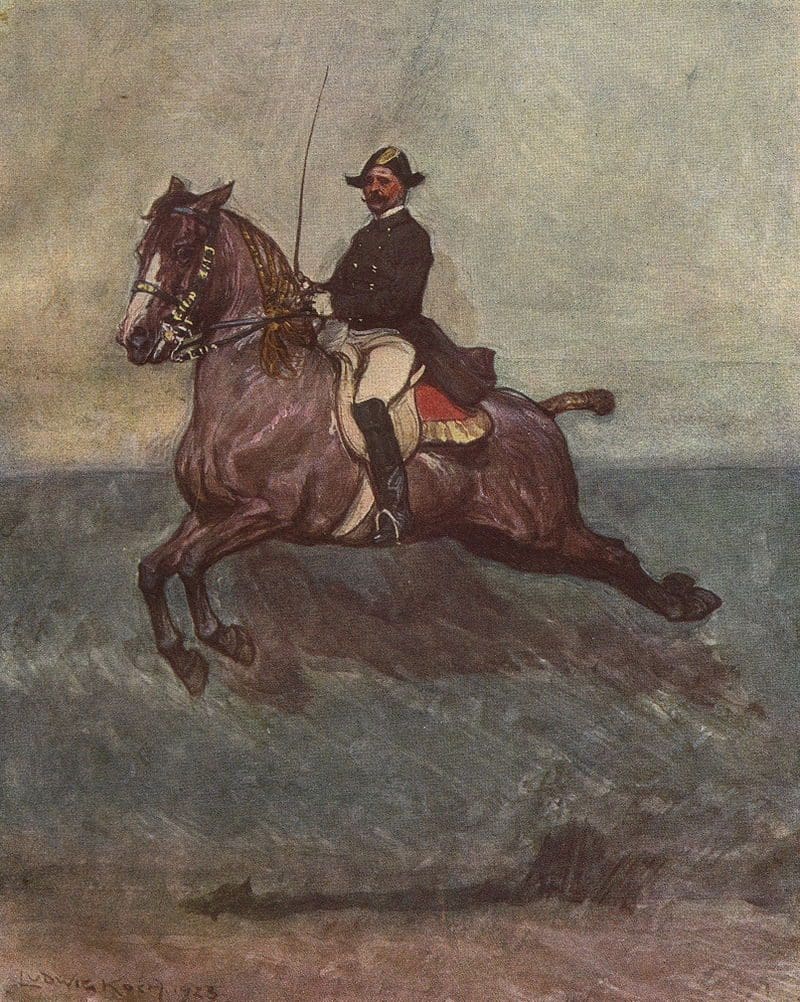
The rudiments of dressage began around 430 BC but did not really develop further until the 14th Century. Read about the important figures who helped shape dressage as we know it today.
As with any pastime that you are really passionate about, I always think it is beneficial to find out as much about the subject as possible. The origins, the history, how it started, who invented it, and why, as this may well increase your enthusiasm and in the case of Classical and Competitive Dressage, help you appreciate how the sport has been influenced over the centuries.
A History of Dressage riding is no exception and in this article, I will give a brief outline of the evolution of horses, how their domestication over the centuries affected the origins of dressage, as well as the important authors and how their contributions shaped dressage history in the 19th Century and 20th Century and the sport we know today.
Scientists do not have conclusive proof and argue about exact dates, but there is an increasing amount of supporting evidence to hypothesize that wild horses were first domesticated around 3,500 BC in the largest temperate grassland in the world, known as the Eurasian Steppe, which runs from Hungary to China. Domestic horses spread from there down toward the Mediterranean and Greece.
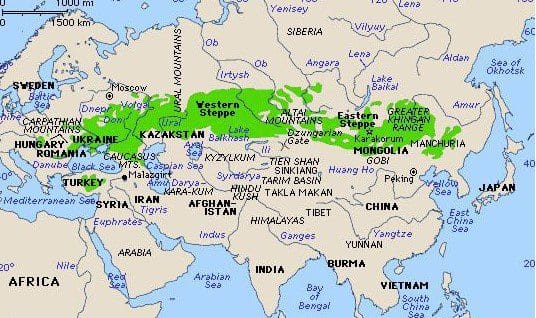
Horses were important in Greek civilization as they were commonly depicted in art, on pottery, in sculptures and statues and this portrayal was consistent throughout Greek History as we know it. The Greeks revered horses as almost mythical creatures and believed they were created by Poseidon their god of the sea. Horses were expensive to purchase and maintain and could only be afforded by wealthier families becoming a status symbol of social standing in Greek Society.
Horses were comparatively small (too small to have been ridden) and only used for driving or pulling chariots. Horses and Chariots were used in Greek warfare between 1600 – 1100 BC, but due to their costs, unit numbers were only very small. Horses did not start to influence battles until the reign of Alexander the Great around 350 BC, bringing us to our first equestrian influencer of the day the Greek writer, philosopher, and General Xenophon.
Xenophon born in 431 BC was a writer and philosopher and at the age of 30 elected commander of one of the largest armies of the day. His manuscript “The Art of Horsemanship” is the earliest surviving written record of horse care and education.
Considering when it was written it is an extraordinary document that espouses the treatment of horses with care and respect. He writes “It is a mark of a good horseman, in our opinion, to see that his groom, like himself, is instructed in the way in which he should treat the horse.” The document discusses in great detail, how a horse should be cared for, trained, and ridden and the following paragraphs provide the first glimpses of what we see in dressage today.
“But in case anyone wants to own a horse suitable for parade, with a high and showy action, such qualities are by no means to be found in every horse: but it is essential that he should have plenty of spirit and a strong body. Many suppose that an animal that has supple legs will also be capable of rearing his body. That, however, is not the case: rather it is the horse with supple, short, strong loins that will be able to extend hind legs well under the forelegs”
“Indeed a prancing horse is a thing so graceful, terrible and astonishing that it rivets the gaze of all beholders, young and old alike. At all events no one leaves him or is tired of gazing at him so long as he shows off his brilliance.”
“If a man buys his horses well, trains them so that they can stand work, and uses them properly in the training for war, in the exhibition rides and on the battle-fields, what is there then to hinder him from making horses more valuable than they are when he takes them over, and why should he not be the owner of famous horses, and also become famous himself for his horsemanship, provided no divine power prevents?”
Over the next centuries, we know that horses found their way into most parts of the world and were being used to transport people, and goods, for farming and of course in military operations. However, since Xenophon’s early cultured approach to horsemanship, there appear to be no further writings on the subject of horsemanship until the late 14th Century, by Dom Duarte the 1st the king of Portugal
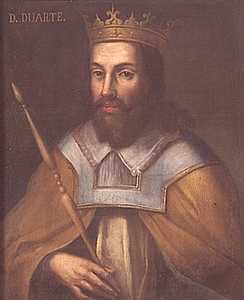
Known as “Duarte the Eloquent”, born in 1391. A reflective and scholarly king whose work entitled “Livro da ensinança de bem cavalgar toda sela” translates as (“Book of Teachings on Riding Well in Every Saddle”) was left unfinished due to his death from the plague in 1438 and published posthumously. In essence, Duarte wrote a Portuguese fencing manual that covered horsemanship and advice on mounted fencing. The book embodies in a very unique way the spirit of knighthood. The result of Duarte’s revolutionary approach to the art of equitation is by focusing both combat and horse-riding techniques on the person behind the skills. Although the book was never finished what remains has similar undertones to that written by Xenophon.
A century after Duarte’s book, the renaissance was in full swing with all roads pointing to Italy. The renaissance was the transition of economic, political, cultural, and artistic beliefs from the middle ages to modernity and Italy was at the center of it all.
Sons of the aristocracy flocked to be part of the renaissance movement and enrolled in new academies that were set up in cities such as Rome, Florence, and Naples, to teach the arts, dancing, fencing, classical literature, and of course riding. This leads us to one of the most famous original authors in dressage history Neapolitan nobleman Frederico Grisone.
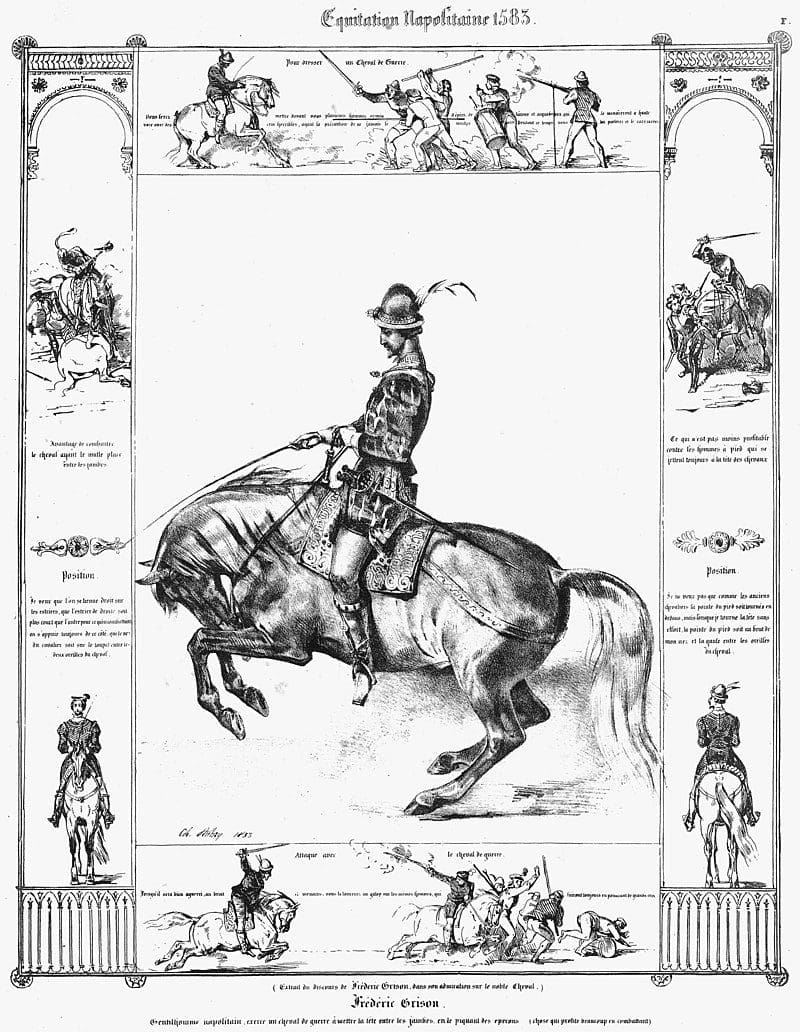
Frederico Grisone established a riding academy in Naples Italy in 1532. He taught students how to ride in a debonair fashion and was the original pioneer of early dressage movements. He was recognised as the “father of the art of equitation” and wrote his first manual on the subject “Gli ordini di Cavalcare” in 1550. Gli ordini di Cavalcare simply translates as the “Rules of Riding” in which he describes the art of manège riding and most significantly is the first to recognise the real importance of trot work, due to its symmetry in motion, being the best gait in which to develop dressage horses.
Many of the doctrines discussed in his writings such as the collection of the horse and the contact between horse and rider are the precepts of what we see in modern dressage riding. Unlike Xenophon who thought that a rider should ride with a relaxed leg and balanced position, Grisones idea of a riders seat position (sitting with feet pushed well forward, a riding style akin to that of a Medieval Knight) is not the classical position we think of today. Grisone also believed contrary to Xenophon that horses were vicious beasts, and used a variety of rather shocking methods to break the spirits of the horses he trained.
Grisones early concepts of haute école or High School movements of classical dressage are still practiced today by such traditional academies as the Spanish Riding School in Vienna, Austria, and the Cadre Noir in Saumur, France.
Grisones work was an immediate success and was soon emulated by other authors. The new written genre of equestrian horsemanship was thus born and is a story that goes from the sixteenth century up to the early 20th Century, forming the basis of modern competitive dressage riding. The next author of note is Cesare Fiashchi.
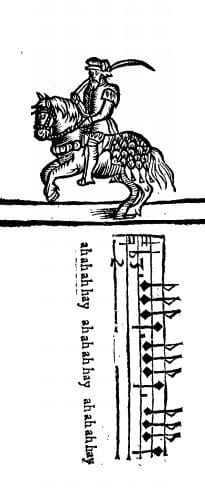
Around the same time as Grisone, Nobleman Cesare Fiaschi was founding his own riding school in Ferrara in 1534 and was purported (but not proved in any documentation) to be the master of the famous Gianbatista Pignatelli, at whose school Salomon de La Broue and Antoine de Pluvinel were educated.
Like his contemporary Frederico Grisone, Fiaschi is one of the founders of early Italian Renaissance horsemanship and the origins of European riding. It was at his riding academy that movement of horses and in particular the cadence of gaits were married to the rhythm of music allowing the horse to perform an elegant dance. In fact, Fiaschi’s treatise is the only book about horsemanship in which a musical score is put aside drawings of certain excises in order to explain the rhythm with which they should be performed.
In 1556, Count Cesar Fiaschi wrote “Trattato del imbrigliare, maneggiare, et ferrare cavalli” A book on harnessing, handling, and shoeing horses and is considered one of the most fascinating and original books ever dedicated to the equestrian arts. Fiaschi’s treatise is the first real manual to set in order the different exercises that could be performed by a perfectly trained animal and laid out exact rules relating to the correct execution of the different movements which allowed for consistency amongst riders.
Proof that Fiaschi had read previous works before him, even ones that are now lost, is the way Fiaschi does not broach specific subjects which had already been covered by other writers of the time. Fiaschi explicitly mentions Grisone’s work, regarding his own book as purely a continuation of authors before him. Just as Grisone did before him, Fiaschi explains the specific singular use of each horse bridle presented in his treatise and that each must be chosen according to the characteristics, attitudes, and defenses specific to each horse. Although never published Gianbatista Pignatelli is worth a mention because of his influence over other famous authors and riders.
Allegedly taught by Cesar Fiaschi and even Grisone, although no documented proof exists Pignatelli was a Neopolitan nobleman who taught equitation in Naples, and although never published, influenced the development of “Alta Scuola”, or classical equitation, both on the Italian peninsula and in France.
He taught a style of riding called “La Brida” (literally translates as the bridle) where the rider stands firm in the stirrups, similar to but not as severe as the Spanish Baroque horse style of riding. His teaching influenced pupils Salomon de la Broue and Antoine de Pluvinel.
Another important manuscript on the treaties of horsemanship worth a mention has recently surfaced and was published by Frédéric Magnin in 2019. It is by Louis de Chardon, Lord of Lugny, born in 1557 in Ferrara Italy but who lived in France. The book entitled “Escolle de L. de Chardon escuyer sieur de Lugny gentilhomme tourangeau en lequelle est monstré l’ordre et methode ques doibt tenir le cavalier envers ses escoliers” (a bit of a mouthful I know but translates as School of Louis de Chardon, horseman, lord of Lugny, a gentleman of the Touraine), in which the orders and method that the rider must observe towards his students are explained, is important for two reasons 1. It is only the second french equestrian manuscript written by a French-speaking author (the other being Salomon de La Broue) and has been dated exactly to 1597 2. Lugny considers “grace” the overriding character of any rider. An orientation that starts with the expression of the face and ends with the elegance and lightness of the seat. The concept of gracefulness and self-assurance should make the act look easy, the exact creed that we all aspire to in dressage today.
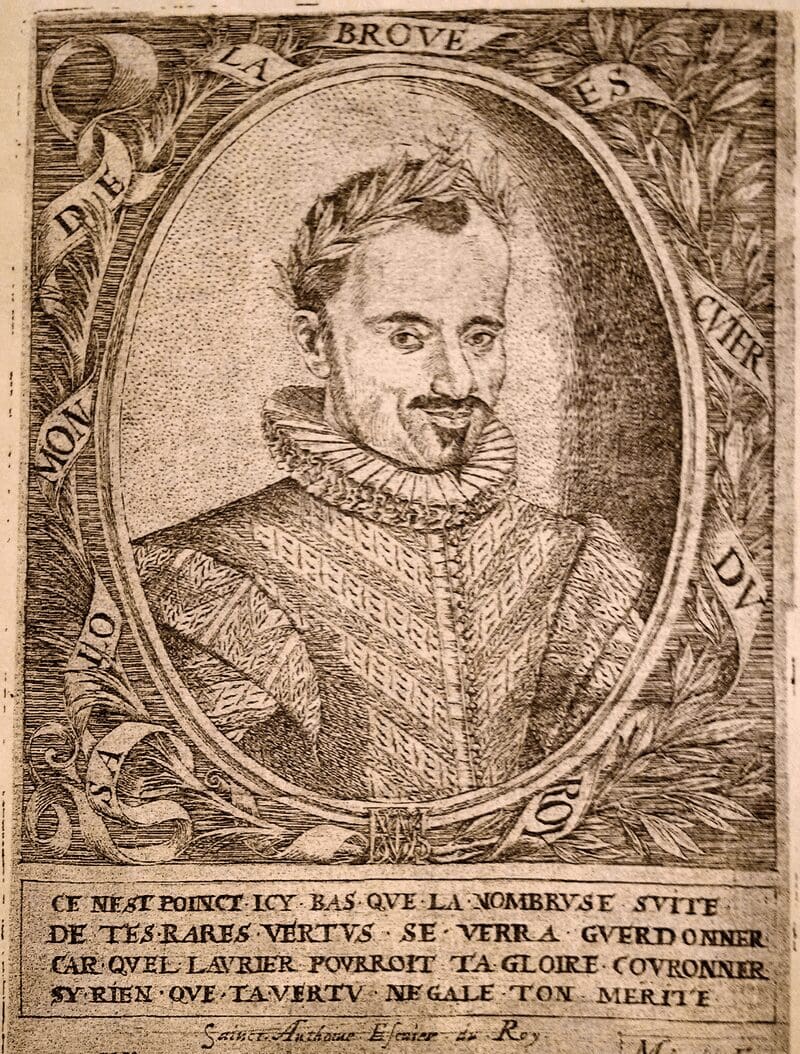
There were two famous students teaching under Pignatelli one was Antoine de Pluvinel and the other Salomon de la Broue. His treatise on riding called Le Cavalerice François:(The French Calvary) was published in 1593 and included principle rules for riding centered around calmness in hand, freedom, and lightness in order to obtain the best results from the horse.
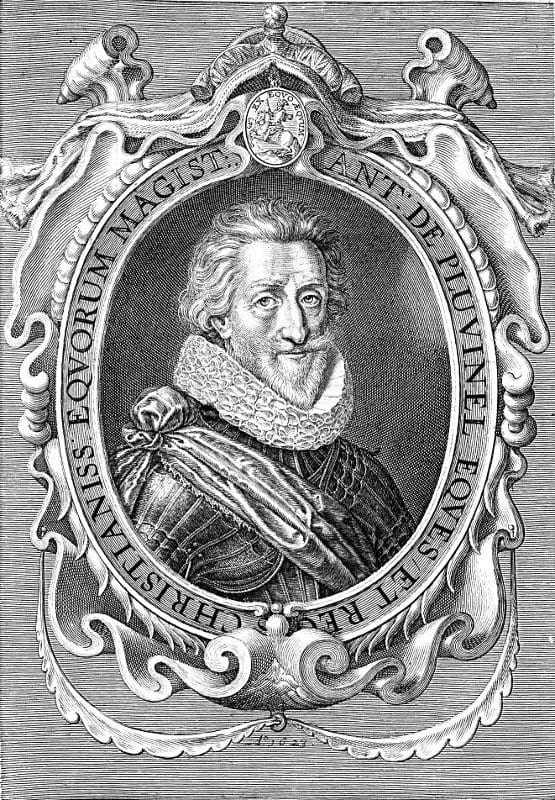
Antoine de Pluvinel was born in 1552 in the province of Dauphine France. Between the ages of 10 and 17 (the exact date has not been documented) he left for Italy to train under the personal teachings of Pignatelli for nearly 10 years, after which he returned to France to continue his studies and was appointed 1st Squire to the Duc D’Anjou (Henri III) accompanying Henri to Poland.
After the death of Charles IX Henri made the journey back to France taking Pluvinel with him. Pluvinel was well rewarded by both Henri III and his brother-in-law Henri IV for services to the crown and in 1594 was given permission to set up a French Academy (“Academie D’Equitation”) in a similar vein to those in Italy, teaching not only horsemanship, but etiquette, dancing, and fashion.
Pluvinel’s societal influence on the aristocracy and his instructions for the art of riding can be evidenced well into the 17th Century and over the years his famous academy taught noblemen such as Richelieu the future prime minister of King Louis XIII and William Duke of Cavendish.
Sadly Pluvinel died in 1620 before his writings could be published, but in 1625 it was published posthumously in its complete form by Pluvinel’s friend Menou de Charnizay called L’Instruction du Roy en l’exercice de monter à cheval (“Instruction of the King in the exercise of horse riding”)
Pluvinel is another author who has had a great influence on modern dressage. His lasting legacy is his humane training methods. He strongly believed in the use of praise, careful use of aids, and softer bits to get horses to work with him in a partnership. Pluvinel maintained that the horse must enjoy the work, which is down to the rider’s gentle understanding of riding, and that the horse will move much more gracefully if he enjoys being ridden. In his teachings Pluvinel’s advanced training methods made the horse more supple, using the pillars in his training of collection and Levade as well as the three-track movement, Shoulder-in, and Voltes.
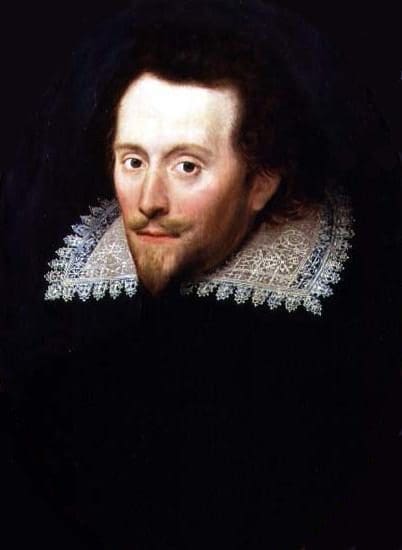
England, although regarded as a country of horse enthusiasts, only produced one early master of classical riding of note. William Cavendish was born in south Yorkshire and was the first champion of early British dressage. He was a celebrated horse breeder, created a Knight of the Bath in 1610, and was elected as a member of parliament. Cavendish had a mixed career as an Army Commander described by Lord Clarendon as “About as fit to be a general as a bishop”.
In 1645 Cavendish moved to Paris before finally settling in Antwerp where he established the famous riding school “The art of Manege” (High School Riding) and published his first work on horsemanship “Méthode et invention nouvelle de dresser les chevaux” in 1658 (A New Method and Extraordinary Invention to Dress Horses and Work them according to Nature.)
Cavendish returned to England in 1660 after the Stuart Restoration and was advanced to Order of the Garter and given a Dukedom (Newcastle upon Tyne) in 1665. Upon retiring from politics he busied himself in his favourite pursuit of training horses and established a racecourse.
Cavendish’s book mentions the writings of Grisone, Pignatel, De la Broue, and Pluvinel and discusses their written achievements and their shortcomings, believing his book to be the ultimate culmination of previous authors.His work can be seen to have influenced probably the two most important visionaries in the history of Equitation, François Robichon de La Guérinière, and François Baucher.
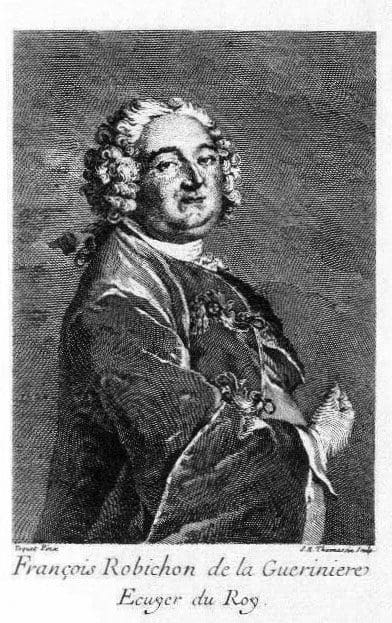
Francois was born in 1688 in Normandy France and studied at the Academie D’Equitation under one of France’s most influential instructors Vendeuil. He was appointed Master of the Stables by Louis XIV in Paris from 1730 until his death in 1751. De La Guérinière wrote one of the most famous equestrian-related books. “Ecole de Cavalerie” “The school of Horsemanship” which details the training of horses, equitation, veterinary treatments, and general horsemanship.
He taught that teaching methods should be gymnastic, progressive, gradual, and logical and are generally followed by all classical and competitive dressage schools today. His exact methods are still taught at the famous Spanish Riding School of Vienna. He is credited with inventing shoulder-in, half halt, counter canter, and flying changes.
De La Guérinière describes shoulder-in as the first and last of all exercises and writes “This lesson produces such good results that I consider it as the first and last of all lessons that we can give to a horse in order to obtain a total suppleness and a perfect freedom in the actions of all the body of the horse.” De La Guérinière’s work describes a progressive schooling system with an overall goal of achieving a light obedient calm horse that is a pleasure to ride.
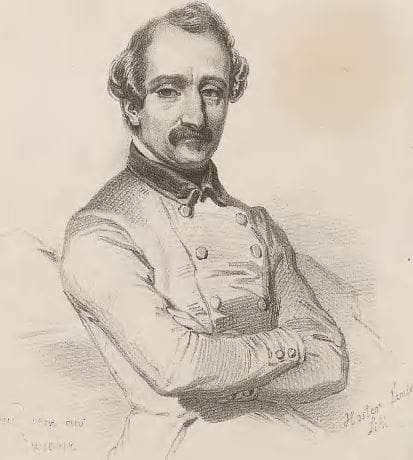
François Baucher was another French riding master, some of whose controversial methods are still debated by dressage enthusiasts to this day. However, his attitudes towards training horses changed over his lifetime and can be seen in his publications often classed as two distinct phases of training. Baucher published several different works on equitation.
Dictionnaire raisonné d’équitation, “Reasoned dictionary of equitation” in 1833;
Le Dialogues sur l’équitation, “Dialogues on equitation” in 1835; and
Le Passe-temps équestres, “Equestrian pastimes” in 1840.
Perhaps Baucher’s most famous book is Le Méthode d’équitation basée sur de nouveaux principes, “Method of riding based on new principles” originally published in 1842 and reprinted numerous times up to 1863. The 12th and 13th Editions of the book contained quite profound changes to his original methods and were called the deuxième manière or second manner, published in 1864 and 1868 respectively.
Baucher’s contemporaries criticised his original training methods for being too harsh for example the principle of substituting the instinctive forces of the horse with the ones transmitted by the rider, which drew criticism for the fact that it was not possible to transmit forces to a horse. In his later edition Bacher clarified that rather than substitute, the rider is able to direct and make use of the forces of the horse. To be fair to Baucher his techniques and training methods were more suited to different types of horses such as thoroughbreds and purebred Arabs that De La Guérinière wasn’t working with at the time.
By the time of the second-period publication more of his systems such as the principle of “hand without leg, leg without hand” has become a widely accepted dressage principle.
Another fundamental technique worth mentioning is the Bauchers system to stop all action from the rider when the demanded movement is obtained. This is specifically mentioned in the FEI rules “The horse gives the impression of doing his own accord what is required of him” Early training with this method can produce great results in respect of obedience to the aids and the appearance of self-carriage. Baucher is also the first to acknowledge in writing horses are intelligent creatures that can respond to the voice.
We must respect the fact that Dressage wasn’t really invented, rather it evolved firstly out of necessity (training military horses) and secondly from political, economical, and cultural changes over the centuries. Each one of the notable characters I have mentioned played their part in the history of classical dressage riding but it is clear that modern-day dressage is ultimately a combination of the methods laid down by Francois De La Guérinière and some of the techniques by François Baucher and that whether it is appreciated or not most competition riders are using these principles today.
Whilst I have described each of the authors and their contributions to the origin of dressage and the history of dressage riding, many of their works are available in print and can provide much more detail about their exact methods than I can possibly write in this article. If you found this article of interest but wish to know more, I encourage you to purchase the treatise and books I have listed below.
Xenophon – The art of horsemanship
Duarte I de Portugal Book of Teachings on Riding Well in Every Saddle
Frederico Grisone Gli ordini di Cavalcare
Cesare Fiaschi – Trattato del imbrigliare, maneggiare, et ferrare cavalli
Louis de Chardon Lord of Lugny
Salomon de la Broue – Le Cavalerice François
Antoine de Pluvinel – L’Instruction du Roy en l’exercice de monter à cheval
William Cavendish Méthode et invention nouvelle de dresser les chevaux
François Robichon de La Guérinière – Ecole de Cavalerie
François Baucher – Le Méthode d’équitation basée sur de nouveaux principes